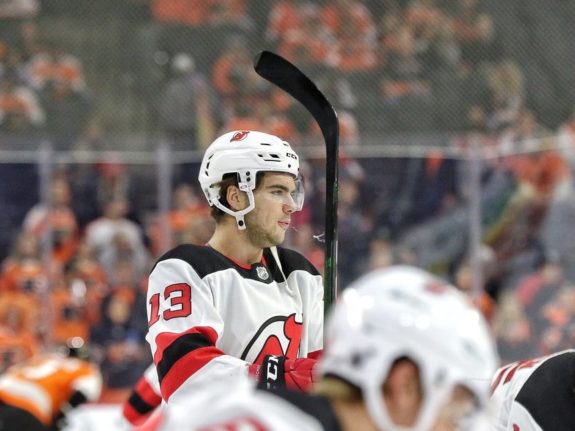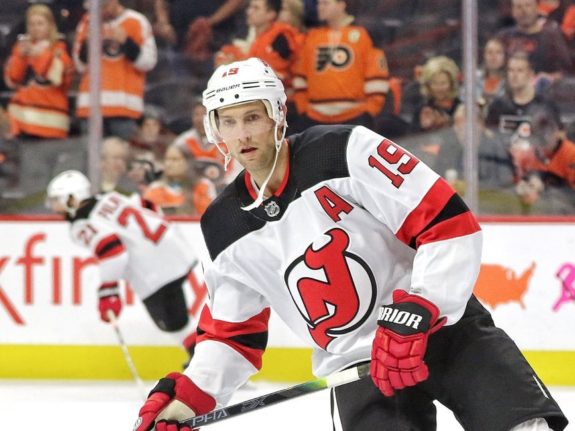After playing some of their best hockey of the season during a 4-1-2 stretch, the New Jersey Devils have taken a bit of a step back. They’ve lost last their last two games and were outscored by a combined 9-2 against the Edmonton Oilers and Calgary Flames, moving them to 4-7-4 on the season.
What’s most concerning about the last two losses is John Hynes’ lineup construction. This hasn’t been a two-game problem, either, as he’s made some questionable lineups this season. That lack of continuity isn’t helping the team, and it hurts even more when certain groups have worked but were broken up without good cause. Here’s what hasn’t clicked, and what has the potential to give Hynes’ team some consistent performances.
What’s Hurt the Devils
Taylor Hall – Nico Hischier – Kyle Palmieri
This line hasn’t been bad at all. The Devils are controlling a majority of the shot attempts and expected goals when they’re on the ice. But it hasn’t been their best first line this season. This unit isn’t generating a ton of offense at five-on-five, as they’re averaging 1.89 expected goals per 60 minutes (xGF/60) and 7.96 high-danger chances per 60 minutes (HDCF/60).

For a line with that much skill, they should be generating more quality looks. They took a step forward against the Oilers on Friday night but weren’t able to convert on their chances. If the Devils want to get more out of their top six, they should break up Hall and Hischier. It’ll help give them more balance up front and would help form a much stronger second line.
Jack Hughes and Nikita Gusev
Gusev and Hughes have played with different wingers when paired together. But it hasn’t mattered much, as the two haven’t been able to find chemistry — they have a 35.59 Corsi for percentage (CF%) and 36.70 expected goals for percentage (xGF%). And that’s created a whole host of problems in taking pressure off of the Devils’ first line.
Related: Devils’ Top Line Needs Hughes
It also doesn’t help that Gusev is struggling to adjust to life in the NHL after years in the KHL. His 36.32 CF% is fourth-worst in the NHL among forwards with 100 minutes played, while his 33.58 xGF% is also fourth-worst. Since Hughes is a first-year player whose defensive game isn’t quite there yet, either, it makes little sense to pair these two together moving forward.
Hughes and Jesper Bratt
In 35 minutes together at five-on-five, Hughes and Bratt have a 34.04 CF% and 33.43 xGF%. Aside from the numbers, both players are pass-first forwards, so if there isn’t a shooting threat alongside them, it’ll be hard to get the desired results. And with Bratt being a weak defensive player, it makes more sense to have him paired with defensively responsible forwards.
What Hynes Should Revert To
Hall – Hughes – Palmieri
This has been the Devils’ best top line, and it’s not close. The team has a 55.43 CF%, 64.74 xGF%, and 70.59 HDCF% when they’re on the ice. They’re also generating the most offense, as they’re averaging 2.96 xGF/60 and 13.28 HDCF/60, which is far better than when Hischier is centering Hall and Palmieri.

Not only has this line created offense, but they’re getting it done defensively, too. They’re averaging 1.46 expected goals against per 60 minutes (xGA/60) and 5.53 high-danger chances against per 60 minutes (HDCA/60). It should be a no-brainer to move forward with these three, especially since the Devils put together some of their best hockey when they were the top line.
Pavel Zacha – Hischier – Bratt/Gusev
Before Bratt’s minor injury, the Devils looked like they had found themselves a second line. In a small sample size of 24 minutes, Zacha, Hischier, and Bratt were dominating at five-on-five. The Devils had a 68.18 CF% and 69.52 xGF% with them on the ice. And they were generating a ton of quality looks, as they were averaging 3.97 xGF/60. Again, it’s a small sample size, but everything they did together was positive.
Related: Devils Smart to Give Hischier Long-Term Extension
A second line around Zacha and Hischier also makes sense because they’re two of the Devils’ best defensive forwards that have offensive upside. They’ll help make up for Bratt’s defensive struggles (the same is true if they’re with Gusev), but it won’t come at the expense of much offense. So it seems like a natural fit for their second line.
Blake Coleman and Travis Zajac
Coleman and Zajac have played a lot of minutes together over the last two-plus seasons. And it doesn’t seem to matter who’s with them because they’ve always found success. In 2017-18, it was Stefan Noesen who helped them form a top shutdown line. Last season it was Miles Wood, while Wayne Simmonds has done the same with them this season.

In their 4-0 loss to the Oilers, the two were broken up for the first time in quite some time. While they both had solid games, it might make sense to reunite them. They’re both stout defensive forwards and can chip in on offense. That could help a forward like Gusev, who struggles defensively, get more comfortable with his game off the puck.
Devils Need Consistent Lines
Lines change all the time in the NHL, but teams also have go-to combos they rely on to get things going. That’d be a concern for the Devils if every line they’ve tried didn’t produce, but that’s not the case. They got results with Hughes centering Hall and Palmieri, while the second unit looked its best with Zacha and Hischier. Put those together, and their top nine could look something like this:
- Hall – Hughes – Palmieri
- Zacha – Hischier – Bratt
- Coleman – Zajac – Gusev
Those top two lines, specifically the first unit, are part of the reason why the Devils went 4-1-2 from Oct. 16 to Nov. 5, but Hynes strayed away from them the last three games. He needs to go back to what worked because they’re in desperate need of some continuity up front. And based on everything else he’s tried, that top nine has the most potential to give him what he needs.
* * *
Advanced stats from Natural Stat Trick